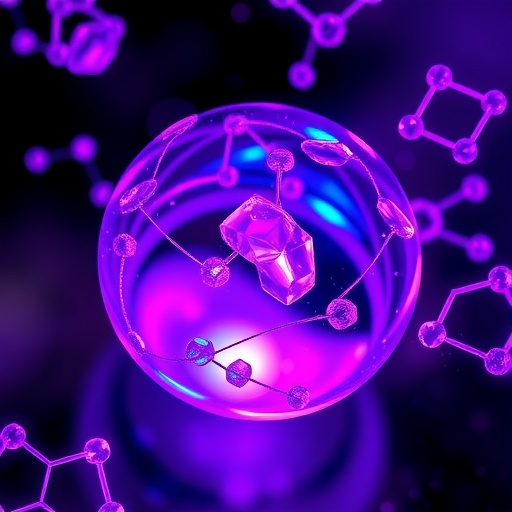In a groundbreaking study, researchers have unveiled new insights into the electrochemical behavior of the europium redox couple within molten fluoride systems. The research, led by a team of scientists including Li, Luo, and Wang, investigated the Eu(II)/Eu(III) redox couple’s dynamics, revealing crucial mechanisms that could influence various applications in materials science and energy storage technologies. By delving into the nuances of electrochemical reactions in molten salts, the study aims to pave the way for enhanced efficiency and stability in systems that utilize rare earth elements.
Electrochemistry has long been at the forefront of energy conversion and storage processes, especially concerning battery technology and renewable energy applications. The unique properties of molten fluorides present opportunities for improved electrochemical performance when incorporating rare earth elements like europium. The innovation here lies in understanding how these ionic environments facilitate or hinder redox reactions, which are pivotal for device functioning. This exploration holds the potential to transform not only battery systems but also catalytic processes and sensor technologies.
Europium, a member of the lanthanide series, has garnered increasing attention due to its unique electronic properties and its role in various applications, including phosphors, catalysts, and phosphorescent materials. The researchers meticulously examined the electrochemical mechanisms underlying the Eu(II)/Eu(III) couple to shed light on its behavior in the molten fluorides, which are often employed as electrolytes in advanced battery systems for their high ionic conductivity and thermal stability.
The investigation employed state-of-the-art electrochemical techniques. Cyclic voltammetry was prominently featured, allowing the researchers to track the redox transitions of europium ions in real-time. By carefully controlling temperature and concentration variables in the molten fluoride system, they generated comprehensive data sets that demonstrate various electrochemical parameters such as diffusion coefficients, reaction kinetics, and thermodynamic stability of the Eu redox couple.
Subsequently, the findings revealed that the electrochemical performance of the Eu(II)/Eu(III) couple is notably sensitive to the composition of the molten fluoride system. Variations in the ionic makeup of these molten salts significantly alter the reaction pathways, activation energy, and overall kinetics. This granular control over electrochemical behavior opens the door to tailoring specific systems for enhanced performance, particularly in high-energy applications where efficiency is paramount.
Moreover, the research pointed to the critical role of solvation and ion interaction dynamics within molten fluoride environments. As the europium ions transition between oxidation states, the surrounding fluoride ions influence both the stability of these states and the energy barriers for electron transfer processes. Understanding how these interactions modulate the redox behavior underscores the importance of both microscopic and macroscopic factors in influencing electrochemical systems.
The study’s implications extend beyond mere scientific curiosity. As the global demand for efficient energy storage solutions escalates, optimizing rare earth element usage in molten salt systems could lead to breakthroughs in battery technology. Innovations in this area can foster developments of high-performance batteries that are both lighter and more energy-dense, critically important for electric vehicles and portable electronic devices.
Research into the Eu(II)/Eu(III) couple is equally significant from an industrial perspective. As industries strive to harness the full potential of rare earth elements in sustainable and economically viable ways, these findings provide essential insights. The proposed models can assist in scaling up production processes and improving the economic feasibility of employing europium and other lanthanides in energy and environmental technologies.
Moreover, the study emphasizes the necessity for ongoing research into the broader family of lanthanides, as variations among these elements can yield different electrochemical behaviors that are yet to be fully understood. Comprehensive studies continuing this line of inquiry may unlock additional potential for novel applications in electronics, catalysis, and advanced materials.
In conclusion, this ambitious investigation into the electrochemical regulation of europium redox couples in molten fluorides illustrates a vital intersection of chemistry and technology. As the world gravitates toward green energy solutions, the optimization of how we use rare earth elements could provide the impetus for the next generation of energy storage devices, like batteries that are safer, more efficient, and environmentally friendly.
The work presented by Li, Luo, and Wang in this realm serves not only to advance scientific knowledge but also to spark collaboration between academic entities and industry leaders in the pursuit of transformative energy solutions. The strategic approaches and experimental frameworks established in this research are bound to inform future studies and innovations as we navigate the complex landscape of electrochemistry and energy sustainability.
As the study is set for publication in 2025, anticipation grows within the scientific community for its contributions to advancing our understanding of electrocatalytic behavior in molten salts, heralding a new era of eco-conscious energy storage technologies.
Subject of Research: Electrochemical behavior and regulation of the Eu(II)/Eu(III) redox couple in molten fluorides.
Article Title: Electrochemical behavior and regulation of Eu(II)/Eu(III) redox couple in molten fluorides.
Article References:
Li, Y., Luo, Y., Wang, L. et al. Electrochemical behavior and regulation of Eu(II)/Eu(III) redox couple in molten fluorides.
Ionics (2025). https://doi.org/10.1007/s11581-025-06780-6
Image Credits: AI Generated
DOI: 10.1007/s11581-025-06780-6
Keywords: Electrochemical behavior, Europium redox couple, Molten fluorides, Energy storage, Rare earth elements.
Tags: battery performance improvementscatalytic processes with europiumelectrochemical behavior of europiumelectrochemical mechanisms in molten saltsenergy storage technologiesEu(II)/Eu(III) redox dynamicseuropium rare earth elementsionic environments in electrochemistrymaterials science innovationsmolten fluoride electrochemistryphosphors and phosphorescent materialsrenewable energy applications





